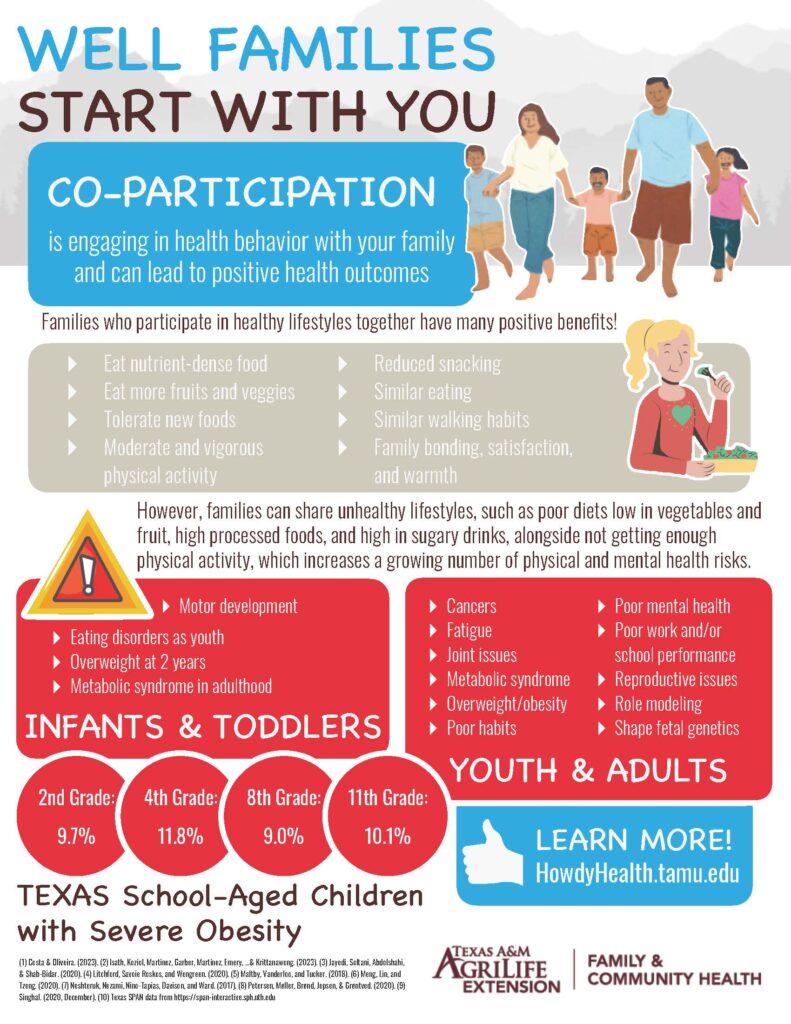Families who participate in healthy lifestyles together have many positive benefits. The most benefits are seen when families co-participate in activities rather than just model the behaviors for each other.1-4 Co-participation is engaging in health behavior with your family and can lead to positive physical activity and nutrition outcomes.
Nutrition
Co-participation within nutrition is the active participation of parental figures in the diets of their children.
Example
Grocery shopping, meal preparation, cooking, and eating together as a family.
It is important for each family member to be involved in the nutrition activities so that they feel as though they have freedom over their own actions. These feelings of freedom help each person achieve autonomy (independence) and relatedness which make them more likely to participate in these behaviors.5 You can co-participate with your children by allowing them to help:
- Create the shopping list
- Select fruits and vegetables while shopping
- Prepare the meal by completing age-appropriate tasks including:
- Selecting fruits/vegetables to be served
- Chopping and/or washing fruit and vegetables
- Using different cooking methods
- Setting the table
- Tossing the salad
- Set nutrition goals
- Number of servings per day and/or week
- Number of new fruits and/or vegetables to try
Families that co-participate in nutrition can experience the following benefits:
- Better mealtime experiences1
- Expand tolerance for new foods1
- Reduce child’s refusal to eat1
- Similar dietary habits2
- Consume nutrient dense foods2
- Reduction in snacking2
Physical activity
Co-participation within physical activity is the active participation of parental figures in physical activity with their children.
Example
Walking, playing sports, playing physically active games, etc. as a family.
It is important for each family member to be involved in planning the physical activities so that they feel as though they have freedom over their own actions. These feelings of freedom help each person achieve autonomy (independence) and relatedness which make them more likely to participate in these behaviors.5 You can co-participate in physical activity with your children by allowing them to help:
- Select the physical activity
- Schedule family physical activity time
- Create a new game
- Set physical activity goals
- Number of days per week to be physically active
- Number of minutes to be active
Families that co-participate in physical activity can experience the following benefits
- Similar walking habits3
- Similar levels of light, moderate, and vigorous activity4
Poor health habits
While families can share healthy habits and reap the benefits, families can also share unhealthy habits. Unhealthy nutrition habits include diets low in vegetables and fruit, high processed foods, and high in sugary drinks. Unhealthy physical activity habits include little to no physical activity and high amounts of sedentary behavior, like watching television and playing on screens.
Co-participation in unhealthy nutrition and physical activity habits can lead to the following poor health outcomes among infants, toddlers, youth, and adults.
Infants & Toddlers2,6,7 | Youth & Adults8,9 | |
Motor development issues | Cancers | Poor mental health |
Eating disorders as youth | Fatigue | Poor work performance |
Overweight at 2 years of age | Joint issues | Poor school performance |
Metabolic syndrome in adulthood | Metabolic syndrome | Reproductive issues |
| Overweight/obesity | Role modeling |
| Poor habits | Shape fetal genetics |
Childhood obesity has worsened over the last several decades and now includes a classification for severe obesity, indicating a child who is at or above 120% of the 95th percentile for their age and sex.
The following represent severe obesity among school-aged children in Texas10
2nd graders | 9.7% |
4th graders | 11.8% |
8th graders | 9.0% |
11th graders | 10.1% |
For more information, consider reading the following SYNC articles:
Infographic
Download the PDF or share the image below to help others learn more about how well families start with you.
References
- Costa, A. & Oliveira, A. (2023). Parental feeding practices and children’s eating behaviors: An overview of their complex relationship. Healthcare, 11 (3), p. 400.
- Litchford, A., Savoie Roskos, M. R., and Wengreen, H. (2020). Influence of fathers on the feeding practices and behaviors of children: A systematic review. Appetite. 147, 104558.
- Neshteruk, C. D., Nezami, B. T., Nino-Tapias, G., Davison, K. K., and Ward. D. S. (2017). The influence of fathers on children’s physical activity: A review of the literature from 2009 to 2015. Preventive Medicine, 102, pages 12-19.
- Petersen, T. L., Møller, L. B., Brønd, J. C., Jepsen, R., & Grøntved, A. (2020). Association between parent and child physical activity: a systematic review. International Journal of Behavioral Nutrition and Physical Activity, 17, 1-16.
- Ryan, R. M., & Deci, E. L. (2000). Intrinsic and extrinsic motivations: Classic definitions and new directions. Contemporary educational psychology, 25(1), 54-67.
- Kerem, L., & Singhal, V. (2020). Overview and Management of Childhood Obesity. In Endocrine Conditions in Pediatrics: A Practical Guide (pp. 349-356). Cham: Springer International Publishing.
- Singhal, A. (2020, December). Obesity in toddlers and young children: causes and consequences. In Nestle Nutr Inst Workshop Ser (Vol. 95, pp. 41-51).
- Isath, A., Koziol, K. J., Martinez, M. W., Garber, C. E., Martinez, M. N., Emery, M. S., … & Krittanawong, C. (2023). Exercise and cardiovascular health: a state-of-the-art review. Progress in cardiovascular diseases, 79, 44-52.
- Jayedi, A., Soltani, S., Abdolshahi, A., & Shab-Bidar, S. (2020). Healthy and unhealthy dietary patterns and the risk of chronic disease: an umbrella review of meta-analyses of prospective cohort studies. British Journal of Nutrition, 124(11), 1133-1144.
- School Physical Activity and Nutrition Survey. SPAN Data Explorer. Retrieved on 04 Sep. 2025. https://span-interactive.sph.uth.edu



